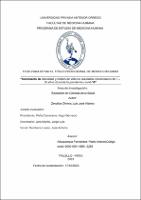Incremento de obesidad y estilos de vida no saludable enescolares de 7 – 16 años durante la pandemia covid-19

Fecha
2023Autor(es)
Zevallos Olivera, Luis José Alberto
Metadatos
Mostrar el registro completo del ítemResumen
OBJETIVOS: Este estudio tiene como objetivo determinar si existe incremento de la obesidad y estilos de vida no saludable en pacientes de 7 a 16 años atendidos por consultorio externo en el servicio de pediatría del Hospital Victor Lazarte Echegaray de Trujillo durante la pandemia del COVID - 19.
MATERIAL Y MÉTODOS: Nuestro estudio fue de diseño observacional, analítico seccional-transversal, se realizó la revisión de historias clínicas de 200 escolares, donde se evidenció 80 obesos y 120 no obesos, luego se procedió a encuestar a los padres de los escolares que fueron atendidos entre 2020 – 2022 para poder determinar si existió incremento de la obesidad y los estilos de vida no saludable en estos pacientes.
RESULTADOS: Nuestro estudio tuvo una población de 200 escolares que fueron atendidos en el servicio de pediatría por consultorio externo, entre el año 2020 – 2022, donde se observó 40% (80) de pacientes obesos, y 60% (120) no obesos, de los cuales se identificó que el IMC promedio prepandemia fue de 19.47 ±3.648 kg/m2 y en la pandemia el IMC incrementó a 21.66 ± 5.370 kg/m2. Tras comparar ambos resultados se obtuvo que la obesidad prepandemia era de un 17% y aumentó a un 40% y su media del IMC fue 2.19325 kg/m.2, por lo tanto, el aumento del IMC en niños obesos fue de 4.555kg/m2 y los no obesos de 0.6194 kg/m2. Por otro lado, los cambios de estilos de vida no saludable si tuvieron significancia estadística con el incremento de obesidad con un (p 0.000), siendo un 5% antes de la pandemia e incrementando a 86% durante la pandemia.
CONCLUSIONES: La obesidad y los estilos de vida no saludable tuvieron mayor incremento en los escolares de 7 a 16 años durante la pandemia, siendo mayor en los niños con obesidad que fueron atendidos en el Hospital Víctor Lazarte Echegaray. OBJECTIVS: This study aims to determine if there is an increase in obesity and unhealthy lifestyles in patients aged 7 to 16 years seen by outpatient clinics in the pediatric service at the Victor Lazarte Echegaray Hospital during the COVID- 19 pandemic.
MATERIAL AND METHODS. Our study had an observational, sectional-cross- sectional analytical design, a review of the medical records of 200 schoolchildren was carried out, where 80 were obese and 120 were not obese, then the parents of the schoolchildren who were treated between 2020 and 120 were surveyed. 2022, to determine if there was an increase in obesity and unhealthy lifestyles in these patients.
RESULTS: Our study had a population of 200 schoolchildren who were treated in the pediatric service by outpatient clinic, between the year 2020 - 2022, where 40% (80) of obese patients were observed, and 60% (120) non-obese, of the which was identified that the average pre-pandemic BMI was 19.47 ± 3.648 kg/m2, and during the pandemic the BMI increased to 21.66 ± 5.370 kg/m2. After comparing both results, it was found that pre-pandemic obesity was 17% and increased to 40% and their average BMI was 2.19325 kg/m.2, therefore, the increase in BMI in obese children was 4.555kg /m2 and the non-obese 0.6194 kg/m2. On the other hand, changes in unhealthy lifestyles did have statistical significance with the increase in obesity with (p 0.000), being 5% before the pandemic and increasing to 86% during the pandemic.
CONCLUSIONS: Obesity and unhealthy lifestyles had the greatest increase in schoolchildren aged 7 to 16 during the pandemic, being greater in children with obesity who were treated at the Víctor Lazarte Echegaray Hospital
Colecciones
- Medicina Humana [2969]

